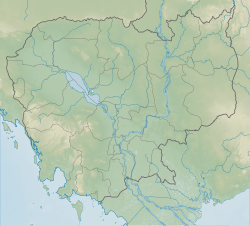
Back Пһном Бахенг Bashkir নম বাখেং Bengali/Bangla Phnom Bakheng German Phnom Bakheng Spanish Phnom Bakheng French Phnom Bakheng Croatian Bakheng Hungarian Phnom Bakheng Italian プノン・バケン寺院 Japanese ប្រាសាទភ្នំបាខែង Cambodian
| Phnom Bakheng | |
|---|---|
ភ្នំបាខែង | |
 The central tower of the temple, September 2022 | |
| Religion | |
| Affiliation | Hinduism |
| Deity | Shiva |
| Location | |
| Location | Angkor, Siem Reap Province |
| Country | Cambodia |
| Geographic coordinates | 13°25′27″N 103°51′22″E / 13.42418°N 103.85601°E |
| Architecture | |
| Type | Khmer (Bakheng style) |
| Creator | Yasovarman I |
| Completed | 889–910 AD |
| Phnom Bakheng | |
|---|---|
 View from the hill | |
| Highest point | |
| Elevation | 79 m (259 ft)[1] |
| Coordinates | 13°25′25″N 103°51′22″E / 13.42361°N 103.85611°E |
| Geography | |
| Location | Angkor, Siem Reap Province, Cambodia |
| Climbing | |
| Easiest route | Hiking |
Phnom Bakheng (Khmer: ភ្នំបាខែង [pʰnom baːkʰaeŋ]) is a Hindu temple in the form of a temple mountain in Siem Reap Province, Cambodia.[2] Dedicated to Shiva, it was built at the end of the 9th century, during the reign of King Yasovarman (889–910). Located atop a hill, it is nowadays a popular tourist spot for sunset views of the much bigger temple Angkor Wat, which lies amid the jungle about 1.5 km to the southeast. The large number of visitors makes Phnom Bakheng one of the most threatened monuments of Angkor.[3] Since 2004, World Monuments Fund has been working to conserve the temple in partnership with APSARA.
History Phnom Bakheng, built more than two centuries before Angkor Wat, was once the main temple in the Angkor region. It was the central architectural feature of a new capital called Yasodharapura, established by Yasovarman when he moved the court from the old capital, Hariharalaya, in the southeast Roluos area.[4]
An inscription dated 1052 AD and found at the Sdok Kak Thom temple in present-day Thailand states in Sanskrit: "When Sri Yasovardhana became king under the name of Yasovarman, the able Vamasiva continued as his guru. By the king's order, he set up a linga on Sri Yasodharagiri, a mountain equal in beauty to the king of mountains."[5] Scholars believe that this passage refers to the consecration of the Phnom Bakheng temple approximately a century and a half earlier.[6]
Phnom Bakheng is one of 3 hilltop temples in the Angkor region that are attributed to Yasovarman's reign. The other two are Phnom Krom to the south near the Tonle Sap lake, and Phnom Bok, northeast of the East Baray reservoir.[7]
Workers built a protective outer moat around the mountain and temple. There were avenues extending in the north, south, east, and west directions from the mountain. A raised pathway, first going northwest to southeast from the old capital to the new capital's outer moat, and then turning to go east to west, connected directly to the east entrance of the temple.[8]
Later in its history, Phnom Bakheng was converted into a Buddhist temple. A monumental Sitting Buddha, now lost, was created on its upper tier. Across its west side, a Reclining Buddha of similar scale was crafted in stone. The outlines of this figure are still visible.
- ^ Google Earth
- ^ Coedès (1968), p. 103.
- ^ Smith, Justine (25 February 2007). "Tourist invasion threatens to ruin glories of Angkor Wat". The Observer.
- ^ Coedès (1968), pp. 112–113.
- ^ Sak-Humphry (2005), p. 38.
- ^ Coedès (1968), p. 112.
- ^ Coedès (1968), p. 113.
- ^ Higham (2001), p. 64.

